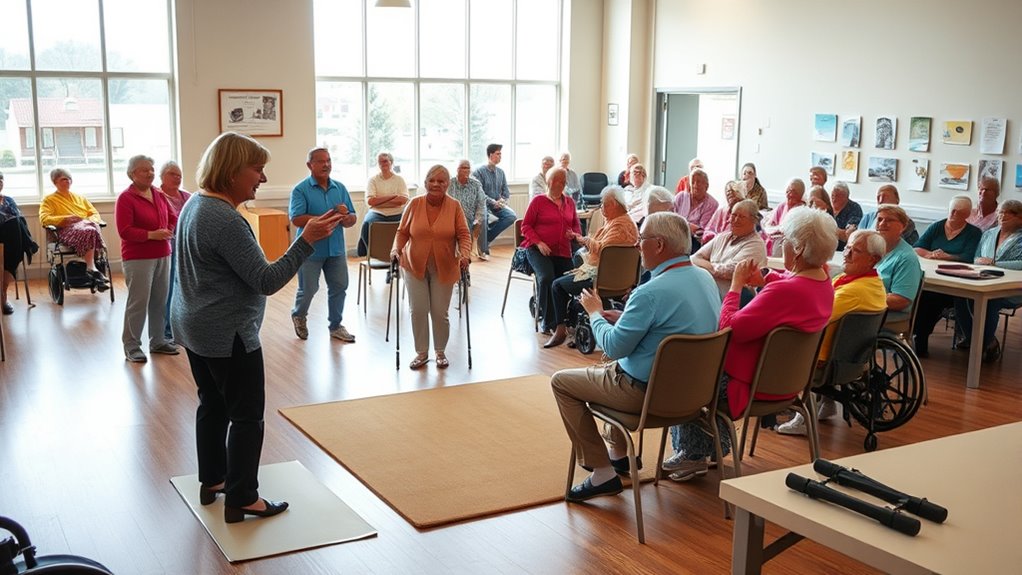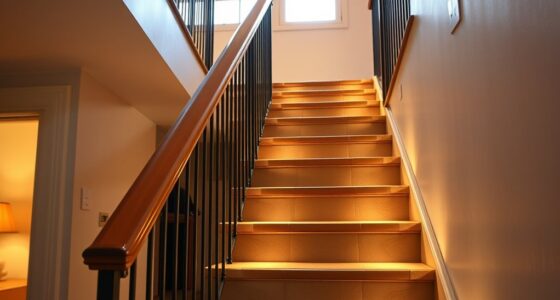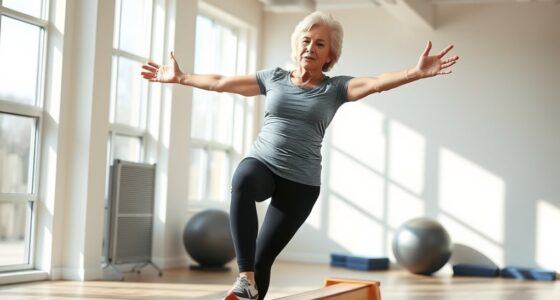Community fall prevention programs for seniors focus on helping you stay safe and independent. These programs typically include home safety assessments, where professionals suggest simple adjustments like grab bars and better lighting. They also offer tailored exercises such as Tai Chi and gentle yoga to boost your strength and balance. Group activities motivate you and promote social connection, while educational resources on footwear and movement keep you informed. Keep exploring to find out how these programs can support your safety and confidence.
Key Takeaways
- Community programs offer home safety assessments to identify and modify hazards, reducing fall risks for seniors.
- They provide tailored exercise classes like tai chi and chair exercises to improve strength and balance.
- Group activities foster motivation, social engagement, and support long-term adherence to fall prevention routines.
- Educational resources cover safe movement, proper footwear, and environmental modifications for safer living environments.
- Trained professionals lead assessments and activities, empowering seniors to maintain independence and confidence at home.

Have you ever wondered how community programs can help seniors stay safe and independent? One of the key ways they do this is by focusing on improving home safety and encouraging regular exercise routines. These programs are designed to address common hazards in the home that might increase fall risk and to promote physical activity that strengthens muscles and improves balance. When you participate in such initiatives, you’re taking proactive steps to create a safer living environment and maintain your mobility.
Community fall prevention programs often include home safety assessments. Trained professionals visit your home to identify hazards like loose rugs, cluttered walkways, or poor lighting that could cause falls. They may suggest simple modifications, such as installing grab bars in the bathroom or rearranging furniture to clear pathways. These changes markedly reduce the chances of accidents and make your home a safer place to live. Knowing that your environment is optimized for safety can give you peace of mind and boost your confidence in moving around independently.
Home safety assessments identify hazards and suggest simple modifications to reduce fall risks and promote independence.
Equally important are the exercise routines incorporated into these programs. Regular physical activity is proven to improve strength, flexibility, and balance—all vital factors in fall prevention. Many community programs offer tailored exercise classes specifically designed for seniors, often led by trained instructors. These classes typically include activities like chair exercises, gentle yoga, or tai chi, which are easy to follow and effective. By engaging in these routines, you not only build physical resilience but also enjoy social interaction, which can boost mental well-being. Consistency is key, so participating regularly helps establish habits that support your overall health.
Participating in community-led exercise routines also offers motivation and accountability. When you’re part of a group, it’s easier to stay committed, and you can learn new techniques or stretches that you might not try on your own. Over time, these routines can lead to noticeable improvements in your balance and strength, reducing your risk of falling. Additionally, many programs provide educational resources about fall prevention strategies, such as proper footwear and safe movement techniques. This combined approach empowers you with knowledge and skills to stay independent longer.
Frequently Asked Questions
How Do I Find Local Fall Prevention Programs in My Area?
To find local fall prevention programs, start by checking with community centers and local clinics in your area, as they often offer or know about such programs. You can also visit your city or county health department websites for resources and schedules. Additionally, ask your healthcare provider for recommendations. These options help you find accessible programs designed to keep you safe and active.
Are These Programs Suitable for Seniors With Mobility Issues?
If you’re wondering whether these programs suit seniors with mobility issues, the answer is often yes. Many programs include tailored exercises designed for varying mobility levels and incorporate assistive devices to help participants stay safe. You should check with the specific program to guarantee they offer adaptations for mobility challenges. This way, you can participate comfortably while reducing fall risk and improving strength.
What Costs Are Typically Associated With Community Fall Prevention Programs?
When considering costs, you’ll find that insurance coverage varies, and some programs may be partially or fully covered, reducing out-of-pocket expenses. Program funding often comes from government grants, local organizations, or community donations, which helps keep costs down. You might encounter fees for assessments, classes, or equipment, but many programs aim to be affordable or free for seniors, making participation easier and more accessible.
How Effective Are These Programs in Reducing Falls?
Imagine a senior attending a local fall prevention program, gaining strength and confidence. These programs often succeed in reducing falls by improving balance and awareness, making them quite effective. However, program success varies, and limitations like participant engagement or access can affect outcomes. Overall, many studies show these initiatives markedly lower fall risks, but they’re not foolproof, and ongoing efforts are essential to maximize their impact and address potential program limitations.
Can Family Members Participate in the Fall Prevention Activities?
You can absolutely participate in fall prevention activities. Family involvement enhances program participation and helps seniors stay motivated. Your presence provides emotional support and encourages consistent practice of safety measures. Many programs welcome family members to join workshops, exercises, or educational sessions. By actively engaging, you help create a safer environment and promote healthy habits, making fall prevention efforts more effective and enjoyable for everyone involved.
Conclusion
So, you now know that community fall prevention programs aren’t just about avoiding bruises—they’re about dodging the embarrassment of being the only one who didn’t get the memo. With all these resources, tips, and support, falling has become a choice, not an accident. So go on, embrace these programs, stay upright, and prove that age is just a number—because falling is so last season. Stay safe, stay sharp, and keep those feet on the ground!









